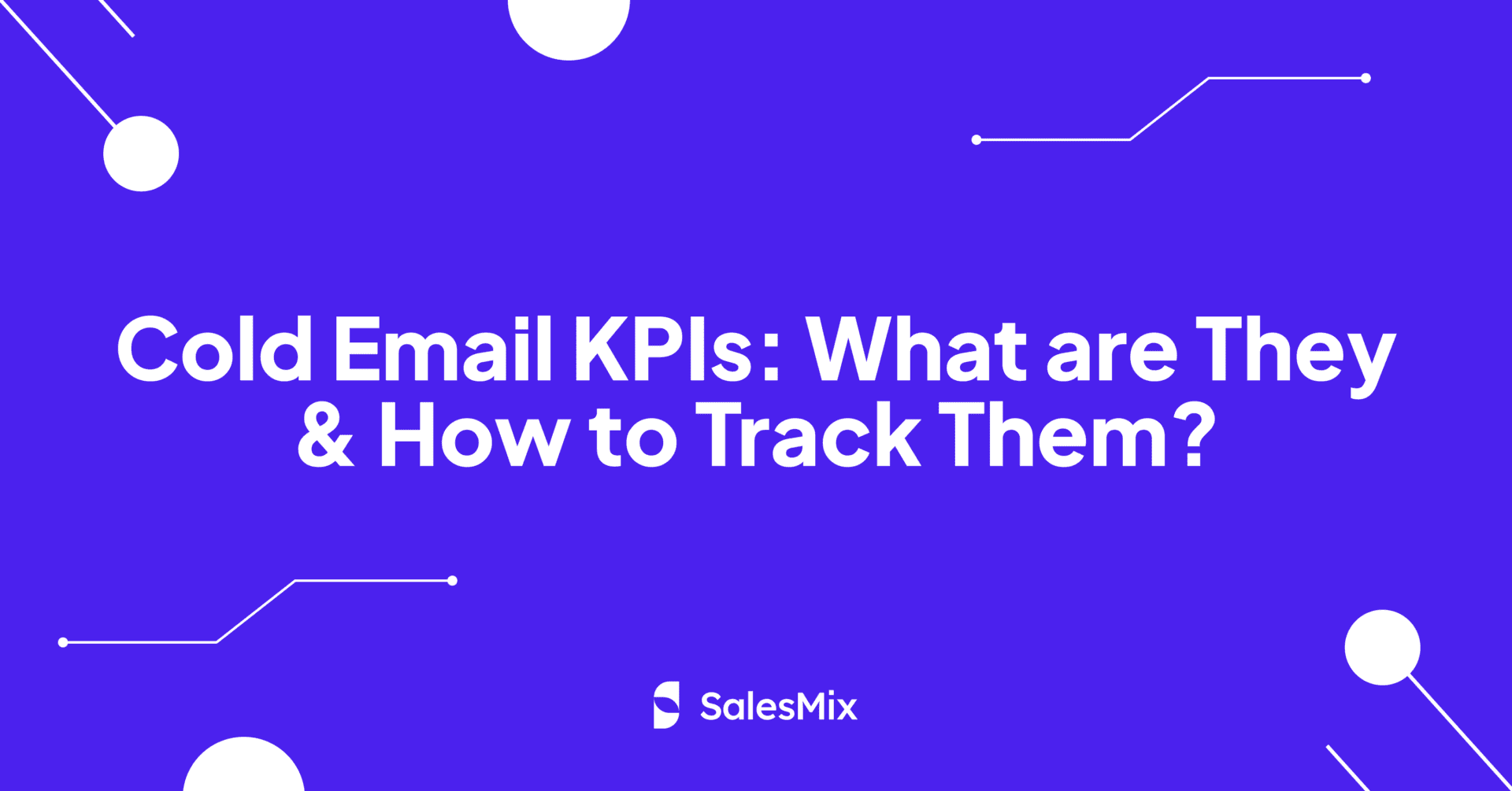Table Of Contents
Do you find yourself questioning which cold email KPIs to track and how they can actually contribute to your strategy?
Understanding the right KPIs to monitor can transform your approach from a shot-in-the-dark to a well-guided strategy capable of delivering measurable and scalable results. However, many marketers and sales professionals struggle to identify the key metrics that can provide real insights into their cold emails’ effectiveness.
In this article, we will explore various essential KPIs, from open rates and click-through rates to more nuanced metrics like conversion rates and revenue per email.
What are Cold Email KPIs?
Key Performance Indicators (KPIs) for cold emailing are crucial metrics that help you gauge the effectiveness of their outreach strategies. These indicators are vital as they directly reflect the initial engagement of potential leads.
Why Should You Track Cold Email KPIs?
You should monitor cold email KPIs to –
-
Understand what works and what doesn’t through open rates, response rates, etc., such as which subject lines capture attention or which content prompts action.
-
Track engagement metrics to refine the content of your emails and better meet the interests and needs of your recipients.
-
Find the optimal times to send your emails to ensure your recipients are more likely to see and act upon your cold emails.
-
Gain quantifiable data that help measure the financial success of your email campaigns.
What are The Types of Cold Email KPIs?
There are 4 main types of cold email KPIs –
-
Deliverability KPIs
-
Engagement KPIs
-
Email List KPIs
-
Revenue and Return on Investment KPIs
Let’s look into them in detail.
Deliverability KPIs
Deliverability cold email KPIs are specific metrics that track the success rate at which emails actually reach the recipients’ inboxes, bypassing filters that could relegate them to spam or other folders. This set of KPIs is critical because even the most well-crafted cold email is ineffective if it fails to be delivered properly.
1. Delivery Rate
The delivery rate measures the percentage of emails that are successfully delivered to the recipient’s mail server, which is the first critical step before an email can engage a potential customer. It lets you closely monitor your email deliverability and evaluate the success of your email outreach efforts by not going to the spam folder.
This KPI’s performance changes due to the quality of the email list, the reliability of the email service provider, and the compliance of the emails with best practices that avoid triggering spam filters.
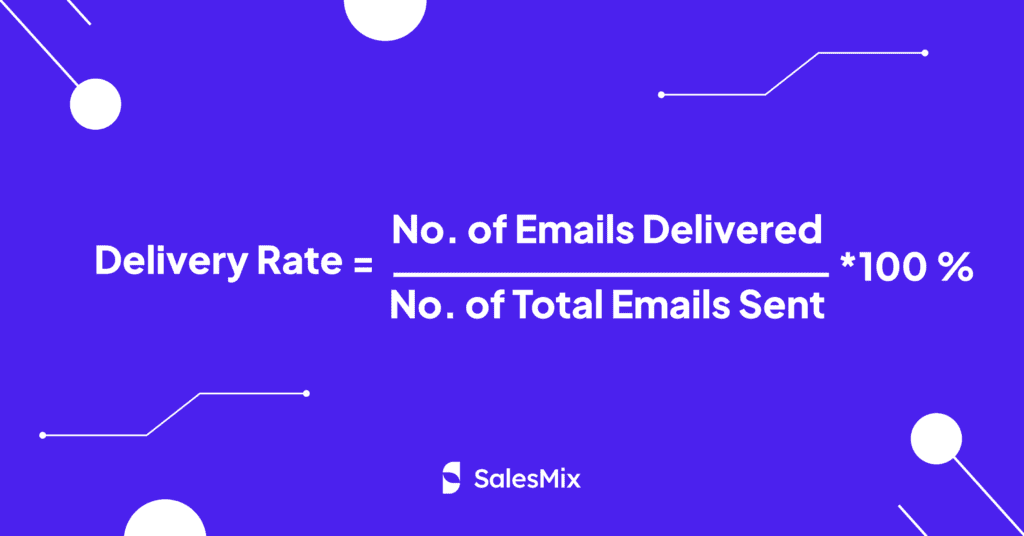
Delivery Rate Formula
How to Improve Delivery Rate?
-
Follow and implement email authentication protocols like SPF, DKIM, and DMARC to verify your emails as legitimate and prevent them from being flagged as spam.
-
Maintain a positive sender reputation with the ISPs.
-
Create relevant and engaging content for the recipients.
2. Bounce Rate
A “bounce” occurs when an email cannot be delivered to the recipient’s server for various reasons, including the recipient’s email address being invalid, the server being unavailable, or the recipient’s mailbox being full. The bounce rate measures the percentage of emails that have failed to be delivered to the recipient’s inbox. It reflects the health and effectiveness of an email list as well as the reliability of email delivery practices.
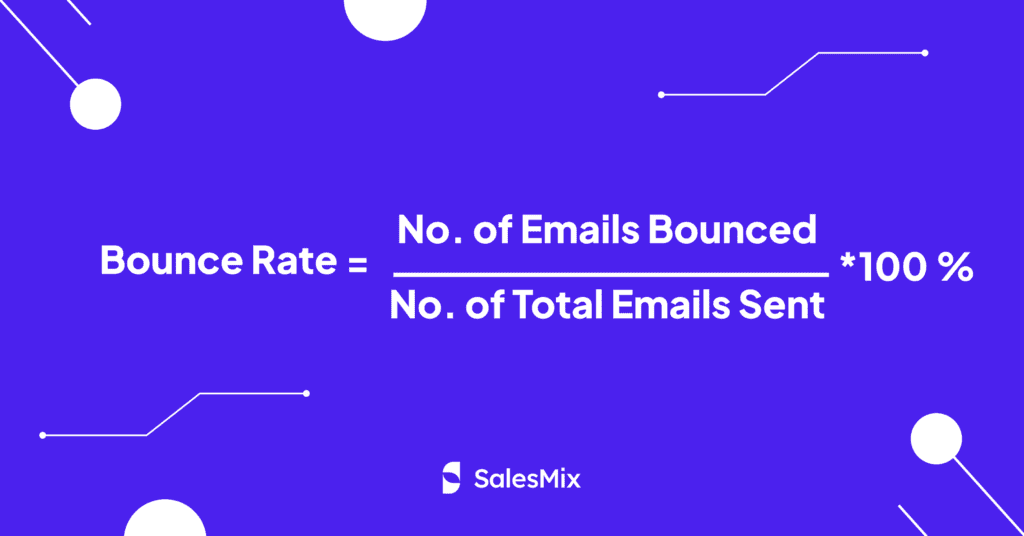
Bounce Rate Formula
How to Improve Bounce Rate?
-
Ensure the accuracy and cleanliness of your email list by regularly removing incorrect or unavailable email addresses.
-
Monitor the feedback from Internet Service Providers (ISPs) and adjust your email-sending practices accordingly.
Engagement KPIs
Engagement KPIs measure how recipients interact with your cold emails. These metrics are crucial for understanding how effectively your messages resonate with your audience.
3. Open Rate
The open rate gauges the percentage of recipients who open an email compared to the total number of emails delivered.
This KPI provides insights into the first level of recipient engagement: whether the email compels enough interest for a recipient to open it. It is invaluable for assessing the effectiveness of your email’s subject line and the overall receptivity of your audience to your messages.
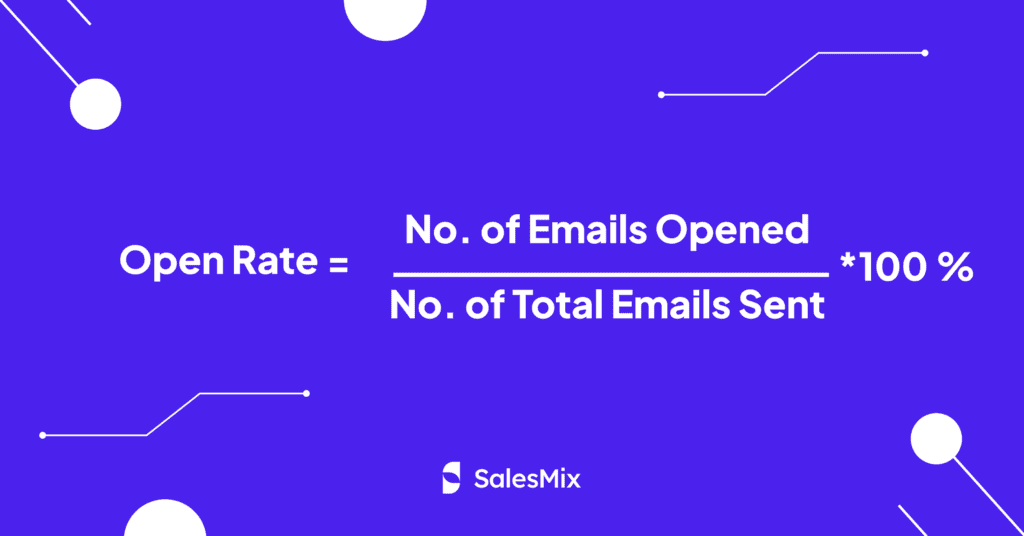
Open Rate Formula
How to Open Rate?
-
The subject line is the most critical factor in influencing open rates, so you should focus on it.
-
Don’t use spammy or extra marketing language in the subject line.
-
Send emails when your target recipients are most likely to be checking their inboxes by researching and experimenting.
4. Click Through Rate
The Click Through Rate (CTR) calculates the proportion of email recipients who click on one or more links within an email. You can use it to assess the relevance and effectiveness of the email’s content and design. A high CTR indicates that the email successfully captured interest and motivated recipients to take a desired action.
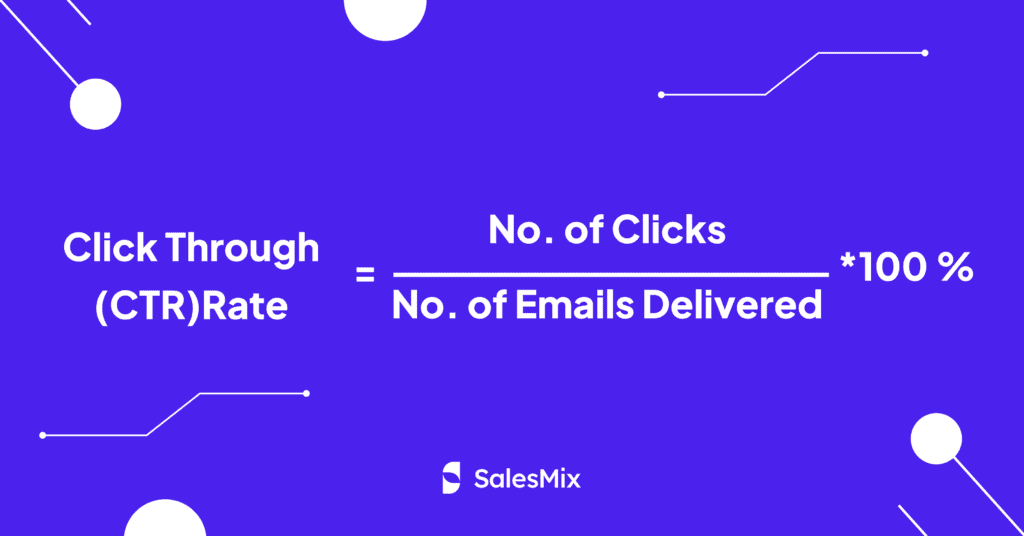
Click Through Rate (CTR) Formula
How to Improve Click-Through Rate?
-
Your cold email’s content needs to be clear and relevant to the recipients.
-
The email content should be easy to read and navigate.
-
Personalization plays a significant role here, so you should contextually personalize your email content.
5. Conversion Rate
The conversion rate measures the effectiveness of an email campaign in driving recipients to complete a desired action. This action can range from booking a demo, signing up for a webinar, downloading a resource, making a purchase, or any other predefined objective relevant to the marketer’s goals.
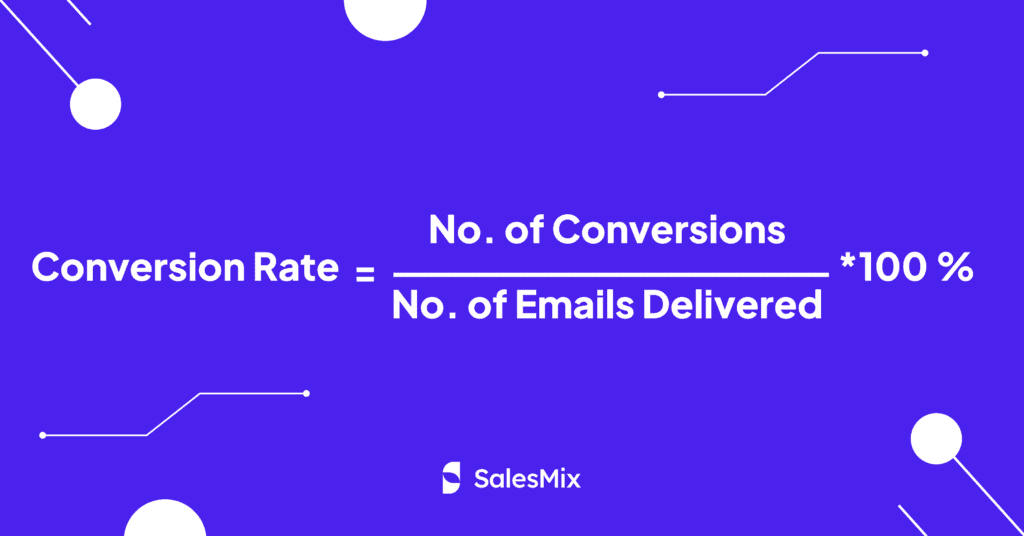
Conversion Rate Formula
How to Improve Conversion Rate?
-
You should have a CTA (call to action) that is prominently placed, easy to identify, and compelling.
-
Establish trust and credibility within the email to prompt the recipients to reply.
-
Make your emails personalized by addressing the recipient by name, referencing their specific needs or past behaviors, and offering relevant solutions that are more likely to resonate and drive action.
6. Reply Rate
The reply rate or response rate gauges the percentage of recipients who respond to an email. This metric is crucial as it provides direct insight into how effectively the email prompts engagement and starts conversations with potential clients or customers.
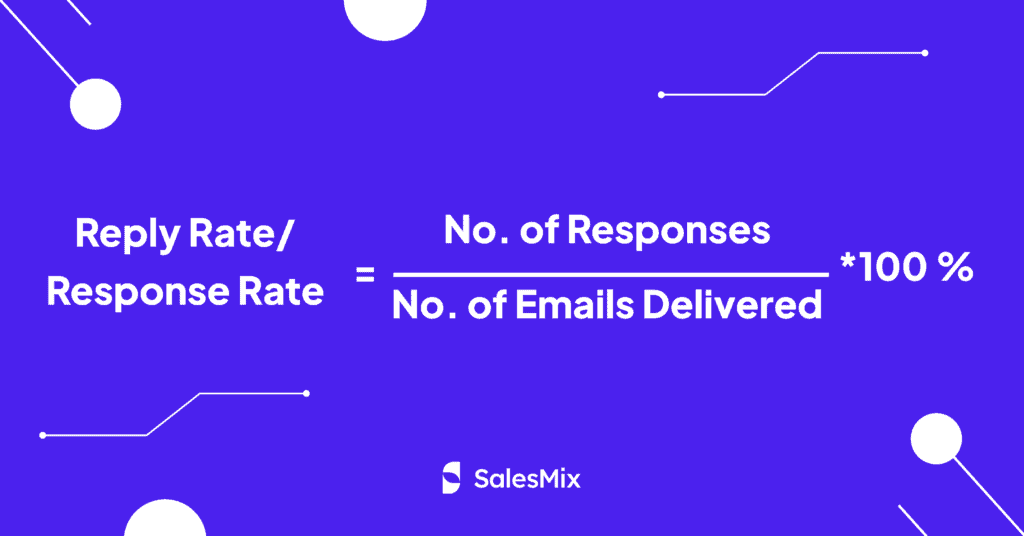
Reply Rate Formula
How to Improve Reply Rate?
-
Your cold emails should directly address the recipient’s needs, challenges, or interests to increase the possibility of bringing out a response.
-
The email should have a clear, compelling invitation, such as a question that prompts a reply, an invitation to schedule a meeting or a request for feedback to engage further.
-
Send cold emails at a time when recipients are most likely to be reviewing their inboxes.
7. Adjusted Reply Rate
The adjusted reply rate assesses how many of these responses are actually meaningful and indicates a potential for further engagement or conversion. It refines the basic reply rate by accounting for the quality and relevance of the responses received.
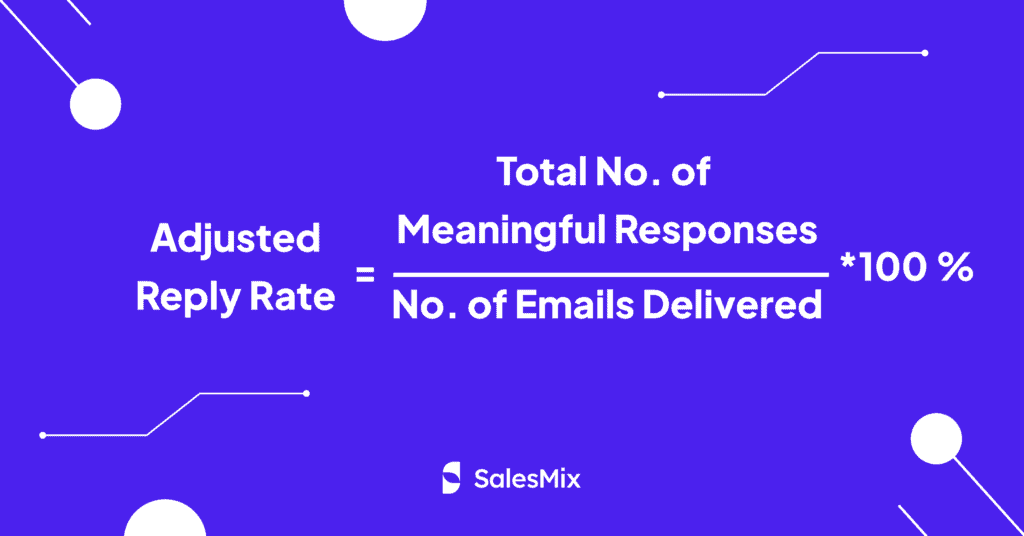
Adjusted Reply Rate Formula
How to Improve Adjusted Reply Rate?
-
High-quality, relevant content that resonates with the recipient’s needs and challenges is more likely to elicit meaningful responses.
-
Create a feedback loop where you analyze the responses for quality and relevance and gain insights that help you continuously improve the targeting and content of the emails.
8. Unsubscribe Rate
The unsubscribe rate quantifies the proportion of email recipients who decide they no longer wish to receive emails from a sender. You can use it to gauge the relevance and acceptance of their email content among their audience. A high unsubscribe rate can signal that the content is not resonating with the recipients or that the emails are too frequent or irrelevant, risking the chance of a high spam complaint rate.
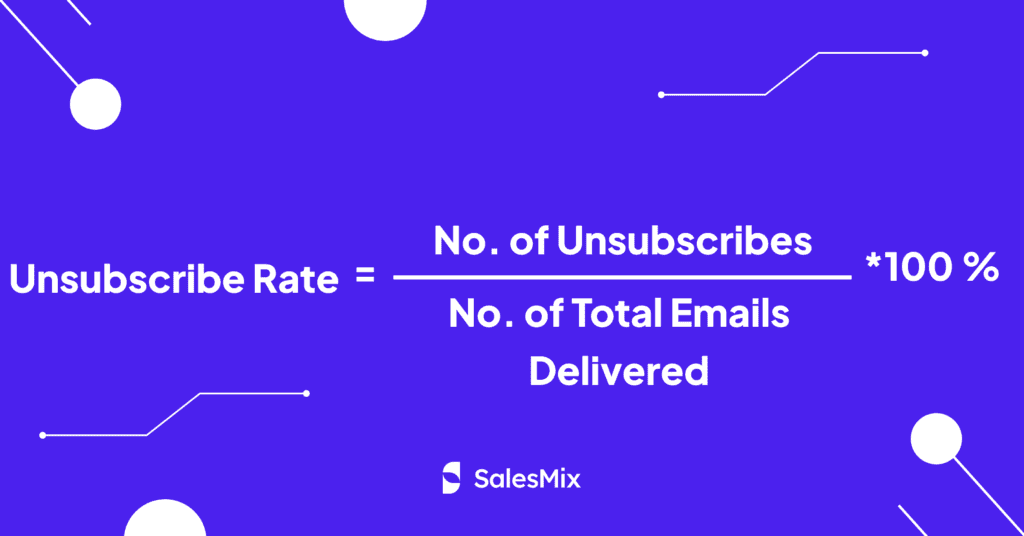
Unsubscribe Rate Formula
How to Improve Unsubscribe Rate?
-
Ensure that the content is highly relevant and engaging to the audience.
-
Find a balance in email frequency that keeps subscribers informed and engaged without overwhelming them.
-
Providing a clear and easy process for opting out to improve the overall user experience and reduce negative feelings towards the brand.
Email List Management KPIs
Email List KPIs focus on the health and efficacy of your email list in cold email marketing campaigns.
9. List Churn Rate
The list churn rate measures the percentage of subscribers who either unsubscribe, have their email addresses bounce, or otherwise become inactive over a specific period. It reflects the attrition in your subscriber base and is critical for understanding the sustainability of your email marketing strategies.
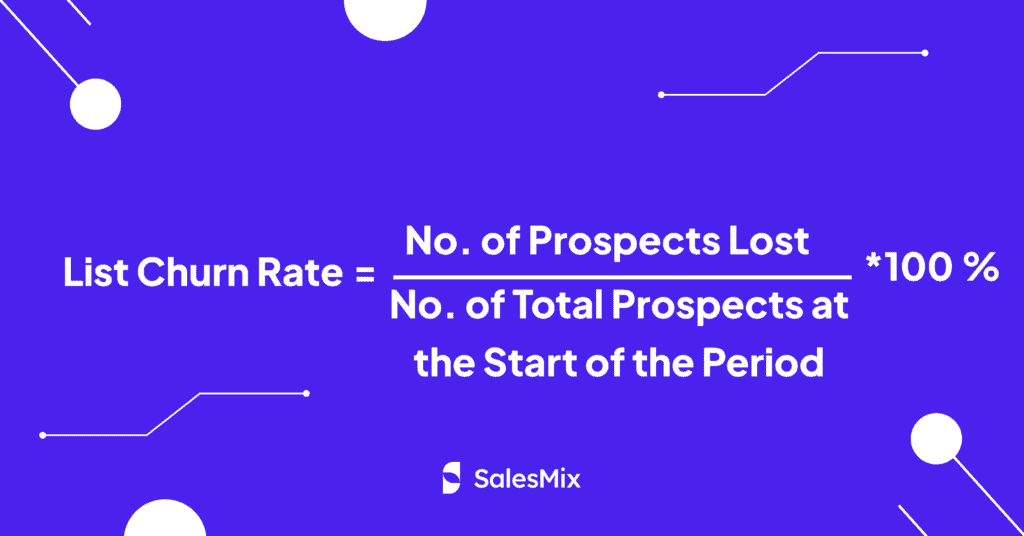
List Churn Rate Formula
How to Improve List Churn Rate?
-
Understand subscriber preferences and deliver content that adds value, whether through insights or offers.
-
Customize emails to fit the specific interests and needs of your audience to reduce churn significantly.
-
Finding the right balance in your email frequency is the key, and it can vary widely depending on your audience and industry.
-
Implement mechanisms to gather feedback from subscribers that can provide critical insights into why subscribers might leave.
Revenue & Return on Investment KPIs
Revenue and Return on Investment (ROI) Cold Email KPIs assess the financial efficacy of cold email marketing campaigns.
10. Cold Emails Per Demo/ Trial
Cold emails per demo/ trial measures the average number of cold emails required to secure one demo or trial of a product or service. It is one of the most important cold email metrics for sales and marketing teams to assess the effectiveness of their outreach strategies in generating tangible interest and moving prospects further down the sales funnel.
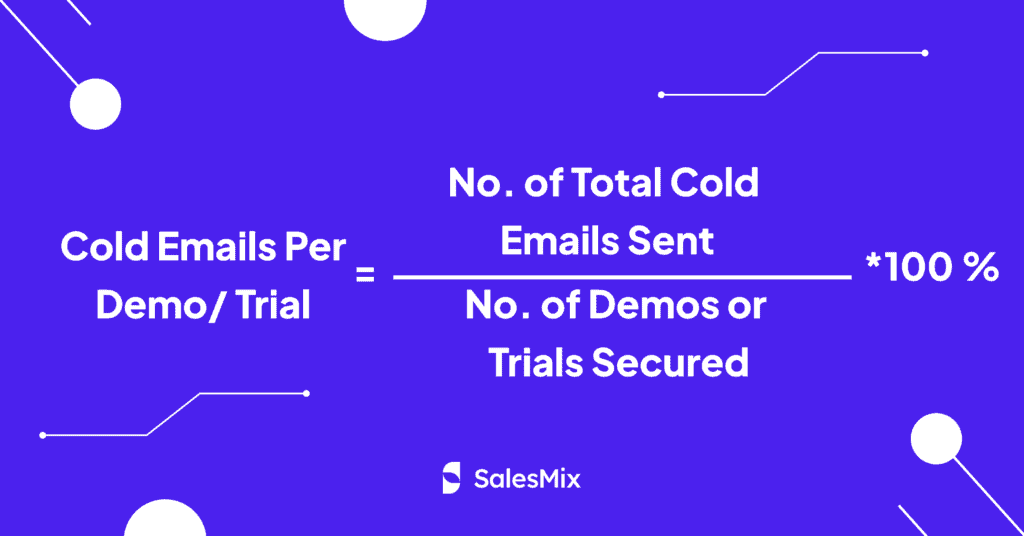
Cold Emails Per Demo/ Trial Formula
How to Improve Cold Emails Per Demo/ Trial?
-
Refine the targeting of your emails to ensure they reach the most suitable prospects can drastically reduce the number of emails needed to secure a demo or trial.
-
The content of the email should resonate with the recipient to prompt them to sign up for a demo or trial.
-
Implement a systematic follow-up strategy to keep the conversation going and gradually build the trust and interest needed to convince a prospect to take the next step.
11. Revenue Per Mail
The revenue per mail metric calculates the total revenue generated from a cold email campaign divided by the number of emails sent during that campaign. This KPI helps you understand how much income, on average, each email contributes, highlighting the profitability of their email marketing strategies.
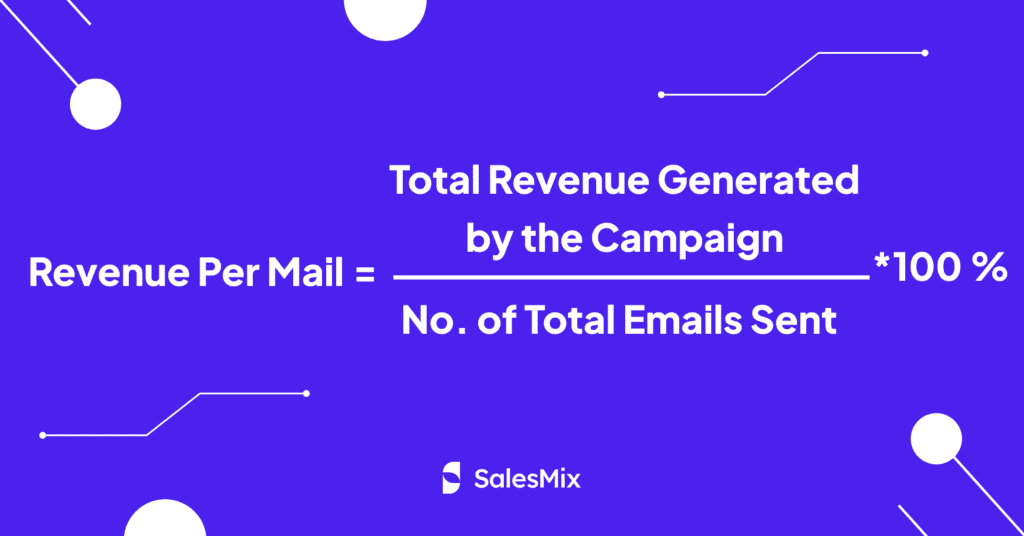
Revenue Per Mail Formula
How to Improve Revenue Per Mail?
-
Regularly test different elements of the email, such as the layout, content, and timing.
-
Analyze the results you get from various tests to identify the most effective strategies.
-
Accurate targeting can ensure that emails reach the most likely buyers or those who have shown interest in similar products or services.
12. Customer Acquisition Costs
In cold email marketing, customer acquisition costs include the costs associated with crafting, testing, and sending emails, as well as expenses related to staff, technologies used for marketing automation and analytics, and any other overheads directly attributable to email marketing efforts.
Businesses use this metric to assess the efficiency and effectiveness of their marketing strategies in terms of the financial investment required to gain new customers.
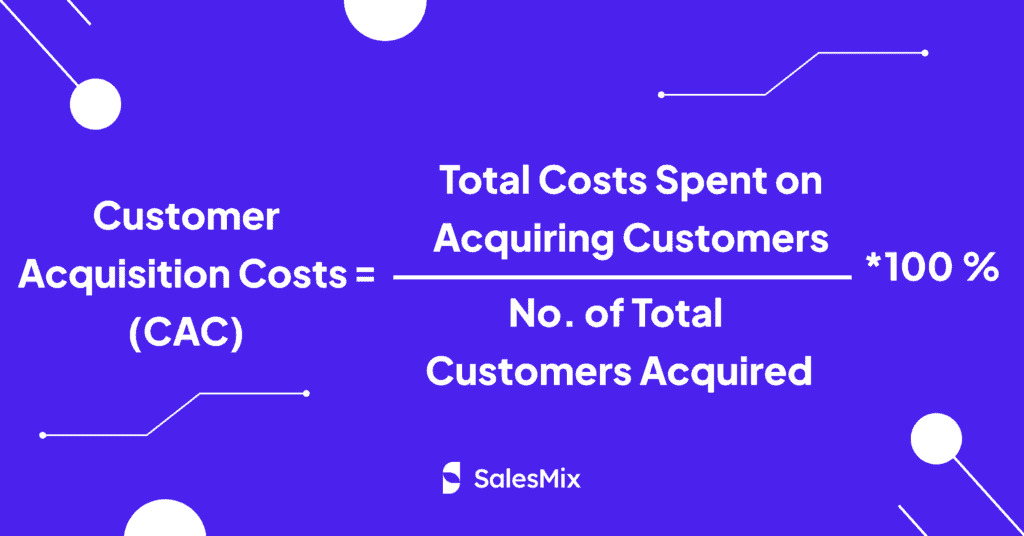
Customer Acquisition Costs Formula
How to Improve Customer Acquisition Costs?
-
Leveraging automation tools to streamline the process of sending cold emails, reducing labor costs and improving efficiency.
-
Streamline the process from initial contact to final purchase to significantly reduce CAC.
13. Return on Investment
The Return on Investment (ROI) of cold emails quantifies the success of email marketing campaigns in monetary terms, comparing the revenue generated directly from these campaigns to the cost of running them. This KPI is vital for businesses to determine whether their investment in cold email marketing is yielding satisfactory financial results.
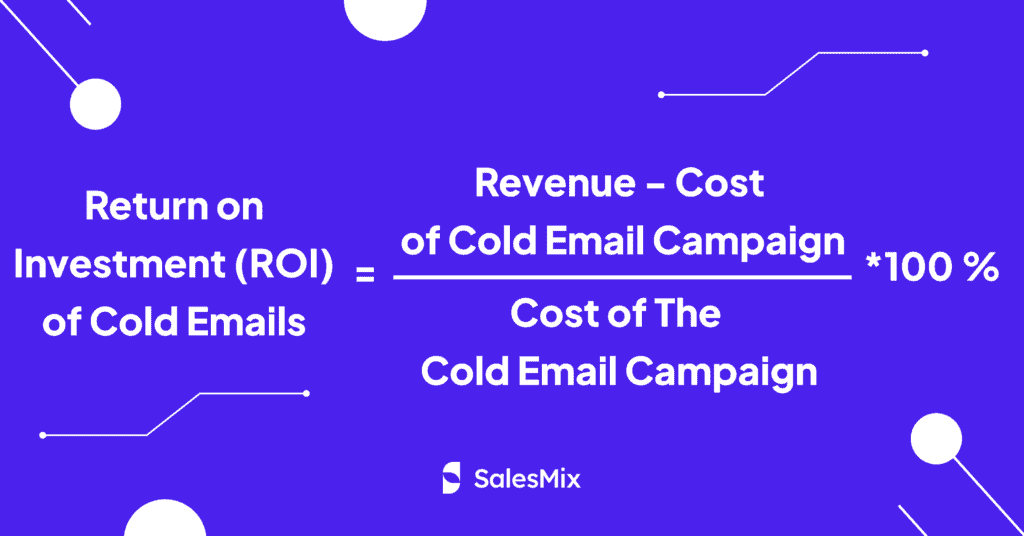
Return on Investment – Cold Email KPIs Formula
How to Improve Return on Investment?
-
Continuously track the performance of your cold email campaigns and implement A/B testing to compare different approaches.
-
Refine your targeting to ensure that your emails reach the most relevant audience and are highly likely to engage and convert.
-
Keep a close watch on the costs associated with your cold email campaigns, including software subscriptions, content creation, and manpower.
Best Practice for Monitoring Cold Email KPIs?
Here are some best practices for keeping track of these crucial metrics:
-
Establish Clear Goals: Before launching a campaign, define what success looks like by setting specific, measurable goals for each KPI you plan to track.
-
Use the Right Tools: Implement robust email marketing solutions, like SalesMix, that provide detailed analytics for tracking open rates, click-through rates, bounce rates, and other relevant KPIs.
-
Test and Optimize: Continuously test different aspects of your emails, such as subject lines, content, and send times. Use the results to refine your approach and improve your KPIs.
-
Act on Feedback: Monitor feedback from unsubscribes and bounced emails to understand why they are not performing well and make necessary adjustments.
-
Maintain List Hygiene: Regularly clean your email list to remove inactive or unresponsive addresses.
Use SalesMix to Monitor & Improve Your Cold Email Campaigns’ KPIs
SalesMix offers a solid solution for monitoring the Key Performance Indicators (KPIs) of your cold email campaigns.
It provides you with a user-friendly dashboard that simplifies the tracking process. With SalesMix, you gain an insightful summary tab directly on your homepage dashboard, making it easy to see crucial metrics at a glance – including the number of emails sent, opened, replied to, and the count of unsubscribes.
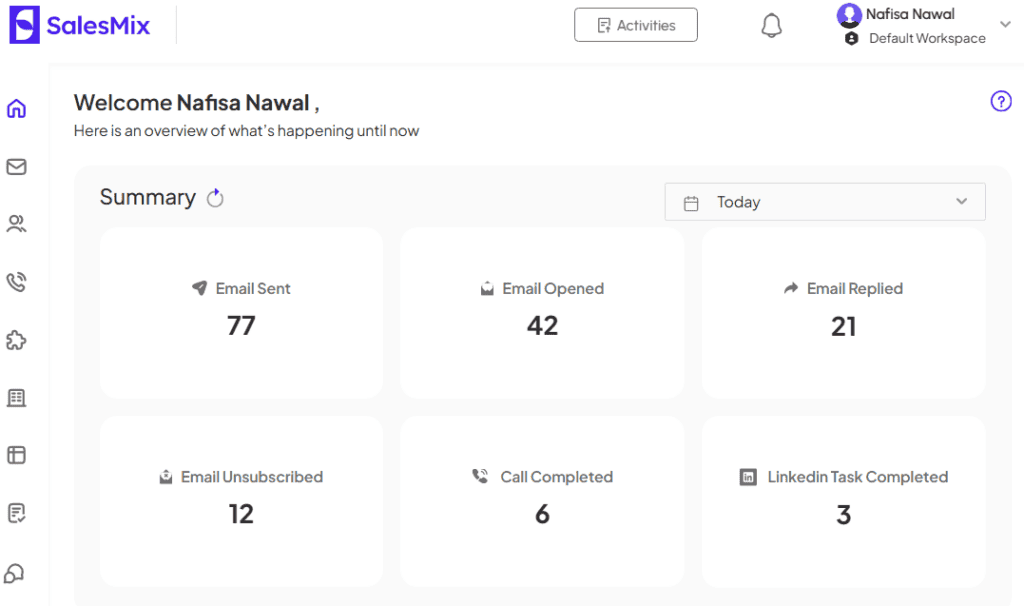
Check Your Cold Email KPIs in SalesMix.
SalesMix, however, doesn’t stop at offering you actionable insights. It lets you improve your performance on various KPIs with its extensive offerings of email warmup, automated email scheduling, email authentication, email testing, personalization, Spintax, and much more.
Conclusion
As we’ve reviewed the essential cold email KPIs, the path forward involves more than mere measurement. It’s about transforming these insights into actionable strategies that refine your approach and amplify your results.
Implementing the improvements suggested for each KPI, such as refining email content, personalizing communication, and optimizing send times, requires a proactive stance. As a result, you should consider each cold email as a component of a larger conversation with your potential customers.

